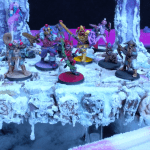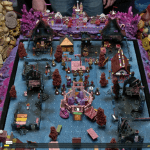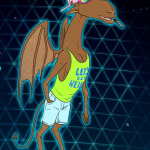“Dimension 20: Shriek Week” Episode 1 Review: The Club Fair

Dimension 20 is known for experimenting with different player groups and even different DMs. The amazing Aabria Iyengar was the first NBLM (non-Brennan Lee Mulligan) with Misfits and Magic, but that wasn’t a one-off situation. She’s coming back for another season, and in the meantime, Gabe Hicks is captaining the Dome for the first time with a four-episode arc called Shriek Week. The first episode, “The Club Fair”, dropped this week and…
You guys, this season is fully a monster dating sim!
It shouldn’t come as a surprise that nearly the first thing we learn about Shriek Week is that it’s a dating sim. Dimension 20 is a group full of comedians, improve actors, and artists, yes, but also a whole bunch of gamer nerds. The, uh… well, to put it bluntly, the monsterf**er gene is pretty strong in those circles (I know because I’m in those circles).
Can I say that? Maybe we’d better use “monstereffer” and keep ourselves out of trouble.
That’s not a criticism! It’s actually refreshing to have a season with very little combat (so far anyway), where every dice challenge in “The Club Fair” has been in a social context. What tickled my fancy is that we were all speculating from the trailer what the “big challenge” was going to be and turns out, it’s finding a good Roëmænce Partnær before the end of the week.
At least, so far.
Let’s back up and tackle the basics. Like Misfits and Magic, Shriek Week has a small table (four players) and a short run (four episodes). My guess as to the logic there is that both Aabria Iyengar and Gabe Hicks are Very Busy People who can’t commit to 15 episode arcs. It’s nice to have these short-run games in the lineup; they offer a chance to still have quality actual play content while the longer seasons are being filmed and edited.
The players are mostly returning favorites: Ally Beardsley from the main cast plus Lily Du from Tiny Heist and Ify Nwadiwe from Escape From The Bloodkeep. We also get to meet writer and actress Dani Fernandez. They’re playing (in order):
- Megan Mirror, a poly-curious ghost with a fermentation obsession.
- Tuti IV, a mummy who’s bent on reinventing herself for Senior Year.
- Terry Talbo, a chill werewolf who’s just a little sensitive about his light facial hair.
- Seven, who’s a vampire with questionable control but more importantly the child of The Count. Like, from Sesame Street.
This season uses a custom game system called Mythic which was created by Hicks just for this table. The dice system reminds me a bit of the Storyteller system, with d10s as the main die type. Hicks does a little rundown of the mechanics early on. Players have attributes of 1-4. On a challenge, players roll the number of d10s indicated by their attribute. They’re looking for a number of successes.
7 and up is a success, 6 and down is a failure. 10 is a critical success (like a Natural 20 in D&D) and 1 is a critical failure.
So when a player wants to make a social roll they grab however many dice they have in social. Let’s say they have a 3. They roll 3 dice and get 2, 7, 10. That’s 2 successes, one is a critical success. They get whatever they need done, and well.
We don’t have a ton of clarity yet on how many successes are needed and how the critical failures work just yet. That’s intentional. Gabe Hicks said online that he didn’t want anyone telling his players they were doing things wrong. I like that- there’s always a lot of kibitzing and critique online.
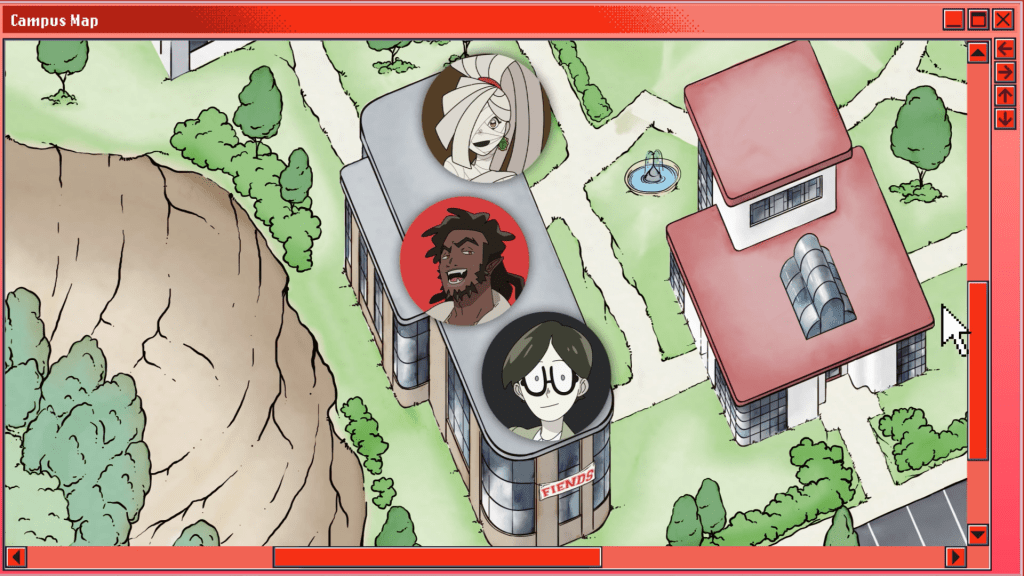
What we do have a ton of in “The Club Fair” is NPCs. We have SO MANY NPCs. This makes sense in a dating sim scenario, because of course, the players need a good wide field of choice. If you’ve ever played a game like Dream Daddy you know each player character needs at least 6-8 potential love interests to choose from, and that’s not counting structural NPCs there to drive the plot.
There’s plenty of variety among the NPCs. We get a host of werewolves, vampires of various flavors, a Japanese Snow Woman, Baba Yagas, mothmen, gorgons, and even several Van Helsing descendants. D20’s Twitter did a solid roundup, which makes me so happy because I won’t have to. Head over and check it out when you’re done here.
As to the story- well, give yourself some time with it. Hicks has a different game style than either Mulligan or Iyengar, both looser and more structured at the same time. By that I mean he gives the players almost complete freedom to explore the world or add to the game lore spontaneously. However, he also nudges the characters firmly along when a scene seems to be dragging and will shepherd a character back to the group if they’ve been separated too long.
You might be tempted to be annoyed by that. Like I said, though, give it time. Hicks is not railroading anyone so much as he is making sure everyone gets to play as much as possible. This is a shorter game, just 4 episodes. There isn’t really time for players to just sit off to the side waiting for their turn to come back. The story flows best when all players are in the same general location, or at least able to observe the same events. In this context, then, we really do need a bit of firm Storyteller guidance.
Once I got over my snobby player prejudice about that, I had fun watching “The Club Fair”. It’s an hour and a half of comedians bantering with each other in the context of coeds seeking romance. There’s a ton of monster puns, a light bit of family drama angst, and some deeply hilarious comments about the value of human life (apparently $20-25).
I’m also enjoying the art this season. Credited over on the Wiki to Bee Arakaki, it’s presented in the context of the Bram University website. As new characters are announced we see their online profile. When events come up there’s a little peek at the website. It’s a cool way to keep the art consistent and push the college theme more.
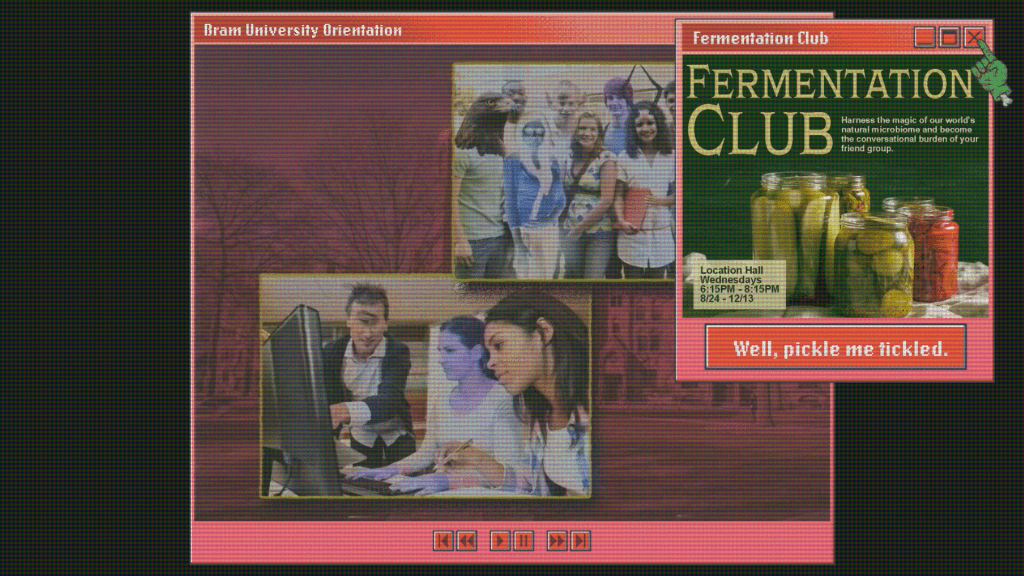
On top of that, Hicks uses some real-world enhancements to give the players a more quality experience. The school announcements were pre-recorded and played as we watched. Hicks also created tailored Shriek Week handouts for each player with brochures, schedules, and some other things I couldn’t see tucked inside. Since they were made for each player, I’m betting there is Secret Information in there. Those little touches added something extra to the game.
They also help me define what kind of DM- well, Storyteller, as he calls himself- Gabe Hicks is. He’s that DM who shows up with artfully aged maps and handmade props for every letter that might be found during the session. You know, the one with a playlist for every mood who also has a two-inch binder with full character sheets for every NPC you might run across.
He does have a more mellow and low-key vibe than the other Dimension 20 GMs which may take some getting used to. All told, though, the world is fun even (especially?) when it’s corny. And I love the thirsty banter thrown around by the players throughout “The Club Fair” (anyone ever wondered how a gelatinous cube would do the deed?).
These episodes are exclusive to DROPOUT but as we’ve pointed out before, this is a very cheap service with a metric buttload of content. You really should treat yourself. We have three more episodes of Shriek Week coming. As usual new episodes drop Wednesdays at 7 pm EST.
See you back here next week!
Author: Khai
Khai is a writer, anthropologist, and games enthusiast. She is co-editor (alongside Alex DeCampi) of and contributor to “True War Stories”, a comic anthology published by Z2 Comics. When she’s not writing or creating games, Khai likes to run more tabletop RPGs than one person should reasonably juggle.
Help support independent journalism. Subscribe to our Patreon.
Copyright © The Geekiary
Do not copy our content in whole to other websites. If you are reading this anywhere besides TheGeekiary.com, it has been stolen.Read our



